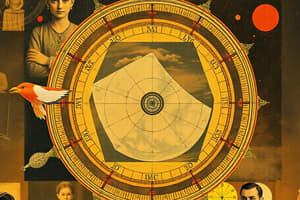Podcast
Questions and Answers
What is the significance of the calendar sticks found in the Andaman islands?
What is the significance of the calendar sticks found in the Andaman islands?
- They recorded solar eclipses.
- They served as astrological predictions.
- They were used to document lunar phases. (correct)
- They traced the path of the stars.
Which ancient civilization is associated with discovered ringstones that may have functioned as calendrical devices?
Which ancient civilization is associated with discovered ringstones that may have functioned as calendrical devices?
- Mesopotamian civilization
- Mesoamerican civilization
- Ancient Egyptian civilization
- Indus civilization (correct)
What celestial event is potentially depicted in rock art patterns found in Kashmir?
What celestial event is potentially depicted in rock art patterns found in Kashmir?
- Lunar eclipse
- Planetary alignment
- Supernova (correct)
- Comet appearance
How was the year structured in the Rig-Veda?
How was the year structured in the Rig-Veda?
What celestial phenomenon did the ancient Indians attempt to reconcile with lunar and solar years?
What celestial phenomenon did the ancient Indians attempt to reconcile with lunar and solar years?
What is a characteristic of the streets in Mohenjo-daro?
What is a characteristic of the streets in Mohenjo-daro?
What aspect of celestial objects did ancient people feel a need to connect with, as suggested in the content?
What aspect of celestial objects did ancient people feel a need to connect with, as suggested in the content?
When do researchers believe the calendar sticks were created, marking the earliest astronomical objects in India?
When do researchers believe the calendar sticks were created, marking the earliest astronomical objects in India?
What does the mention of ‘3,339 gods’ in the historical context likely refer to?
What does the mention of ‘3,339 gods’ in the historical context likely refer to?
How many lunar mansions or nakṣatras does the Yajur-Veda list?
How many lunar mansions or nakṣatras does the Yajur-Veda list?
What was the approximate date range for the Vedāṅga Jyotiṣa as dated by scholars?
What was the approximate date range for the Vedāṅga Jyotiṣa as dated by scholars?
What is the length of the sidereal day as mentioned in the Vedāṅga Jyotiṣa?
What is the length of the sidereal day as mentioned in the Vedāṅga Jyotiṣa?
What does the term 'adhikamāsa' refer to in astronomical context?
What does the term 'adhikamāsa' refer to in astronomical context?
Which period is characterized by the development of Jain astronomy?
Which period is characterized by the development of Jain astronomy?
What significant time scale was conceived during the early historical period?
What significant time scale was conceived during the early historical period?
How does the solar year compare in days to the lunar year?
How does the solar year compare in days to the lunar year?
What was a consequence of the difference between the solar and lunar years?
What was a consequence of the difference between the solar and lunar years?
What influences were potentially observed in the astronomical developments during this period?
What influences were potentially observed in the astronomical developments during this period?
Flashcards are hidden until you start studying
Study Notes
The Beginnings of Indian Astronomy
- The earliest astronomical artifacts in India date back to the palaeolithic era, approximately 12,000 years ago, and include calendar sticks from the Andaman Islands for tracking lunar phases.
- Rock art in Kashmir, thought to represent a supernova and meteor showers, suggests early astronomical observations around 7,000 years ago.
- Ringstones found at Mohenjo-daro (Indus civilization, 2600-1900 BCE) may have functioned as calendrical devices to monitor the sunrise throughout the year.
- The streets of Mohenjo-daro are perfectly aligned to the east-west, potentially reflecting observations of the star cluster Pleiades (Kṛttikā).
- The Rig-Veda, the oldest of four Vedas, mentions a 360-day year divided into twelve parts and records a solar eclipse metaphorically, indicating early astronomical knowledge.
- The "3,339 gods" in the Rig-Veda might reference the 18-year lunar eclipse cycle known as the saros, highlighting an ancient tradition of eclipse observation.
- The Yajur-Veda presents a lunar year of 354 days and a solar year of 365 days, categorizing the year into six seasons (ṛtus).
Development of Calendrical Astronomy
- The late Vedic period saw advancements in calendrical astronomy, culminating in the Vedāṅga Jyotiṣa text by Lagadha, the first known Indian scientific work, dating between the 12th and 14th centuries BCE.
- The text accurately calculated the length of the sidereal day as 23h 56m 4.6s, showing a difference of only seconds from the true value, reflecting high precision.
- The Vedāṅga Jyotiṣa discusses astronomical phenomena such as solstices and equinoxes and introduces intercalary lunar months to maintain alignment with the solar calendar.
The Early Historical Period
- Spanning the 3rd century BCE to the 1st century CE, this period involved intricate astronomical computations based on planetary movements and positions.
- Jain astronomy emerged during this time, characterized by a unique dual model consisting of 27 nakṣatras, two suns, and two moons, contributing to advanced calendrical calculations.
- Concepts of immense time scales arose, including the ‘day of Brahmā’ (kalpa) estimated at 4.32 billion years, which is remarkably close to contemporary scientific estimates of Earth's age.
- Influences from Babylonian and Greek astronomy were noted, particularly in the introduction of the seven-day week, showcasing cross-cultural exchanges during this period.
Studying That Suits You
Use AI to generate personalized quizzes and flashcards to suit your learning preferences.




